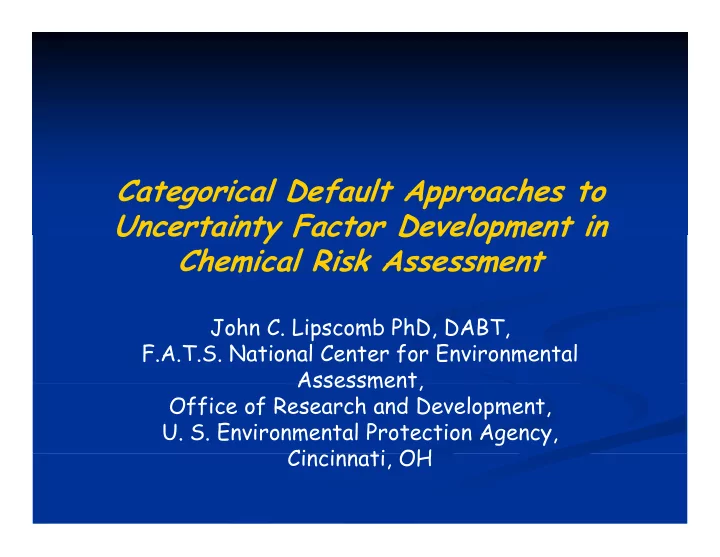

Categorical Default Approaches to Uncertainty Factor Development in y p Chemical Risk Assessment John C. Lipscomb PhD, DABT, F.A.T.S. National Center for Environmental Assessment Assessment, Office of Research and Development, U. S. Environmental Protection Agency, Ci Cincinnati, OH i ti OH
Where Does this Fit in Human Health Risk Assessment? Risk Assessment? NAS 4-Step Paradigm Hazard Assessment & Characterization & Characterization Dose Response Assessment Exposure Assessment & Characteri ation & Characterization & Characteri ation & Characterization Risk Assessment & Risk Assessment & Characterization
Mode Mechanism Detailed Detailed Plausible Plausible Molecular Hypothesis with Description p Measured Key Measured Key of Causality Events Key event: Critical Quantifiable
MOA/HR (WOE) Framework Q1. Is the weight of evidence sufficient to establish the MoA in animals? I Implications of li ti f Kinetic & Dynamic Q2. Fundamental qualitative Data for Data for differences in key events? differences in key events? Dose– Response Q3 Fundamental quantitative Q3. Fundamental quantitative differences in key events?
Biologically (MoA) (MoA) Default Default Based Reference/Acceptable/ Reference/Acceptable/ Tolerable Intakes = N/LO(A)EL or BMC/D N/LO(A)EL BMC/D � Kinetics UF � Dynamics U Uncertainty Factor i F Interspecies Differences ( 10) (x10) Human Variability (x10) Ad Adequacy of database f d t b (x1-100) 5
The Continuum Default � Data-Informed � Default – 10 x 10 � Database - Derived - databases of information, , not group or chemical-specific � Categorical - applies to categories of substances/species based on their characteristics (BSA substances/species based on their characteristics (BSA correction; RFC - gases/particles) � Chemical Specific Adjustment Factors - p j addressing kinetic or dynamic aspects with chemical specific or compound-related information � Fully Data-Derived – biologically-based dose- Fully Data Derived biologically based dose response modelling addressing kinetic and dynamic aspects 6
Where Are We Trying to Go in A Ri k C Risk Context? t t? � Greater predictive power � Higher relevance Hi h l � Moving from default to more biologically b based d � Relevant pathways � Relevant doses Relevant doses � Relevant species
U.S. NRC/NAS Toxicity Testing in the 21 st Century Dose Response Dose Response Assessment Chemical Mode of Action M d f A ti Characterization Population Based Studies C Compounds d Affected Dose Response Pathway Calibrating Analysis for Exposure in vitro and human Perturbations Guideline Assess Dosimetry of Toxicity Biological Pathways Perturbation Perturbation Measures of dose in vitro Metabolite(s) Human Exposure Data Hazard Characterization Exposure Assessment E p u m n Risk Characterization
Categorical Default Approaches to Uncertainty Factor Development in y p Chemical Risk Assessment John C. Lipscomb PhD, DABT, F.A.T.S. National Center for Environmental Assessment Assessment, Office of Research and Development, U. S. Environmental Protection Agency, Ci Cincinnati, OH i ti OH
Recommend
More recommend